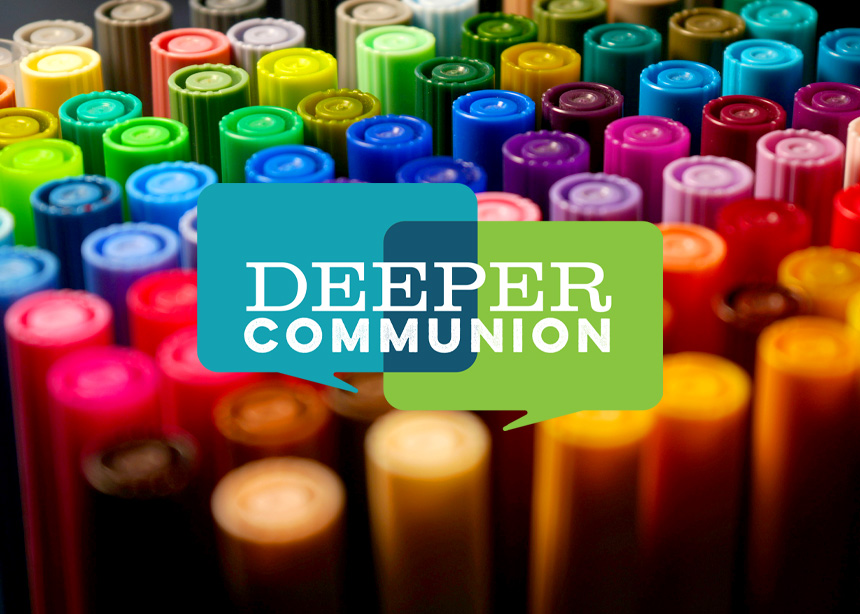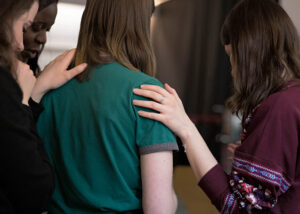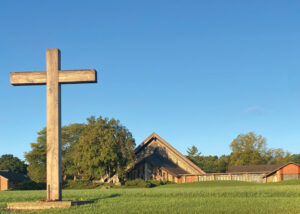For my birthday last month, I asked for markers.
Since then, I’ve spent several hours in my soft front-room chair, copying out verses from the Psalms in a large, empty sketchbook I’ve had for years, illuminating the letters like a not-very-talented medieval scribe. I meditate on the words as the texture of the paper, the hues of the inks and the angles of the letters draw me into something like presence. I am finding a place to breathe in the company of Christ.
This isn’t a new practice for me. I first did it as a teenager. In fact, I have those prayer journals in a box in my basement—spiral-bound sketchbooks at least 25 years old. My family went through some truly hard times in those years, and I made it through with glittery gel pens, copying out verses, scrawling out my longings, laying out my heart before God. I was (and am) deeply earnest, deeply empathetic, moved by every close and far-off pain. I needed to find rest, and in that simple practice, filling pages with pretty letters, sitting with promises of God’s protection and presence, I did.
I’m looking for that rest again these days.
A few months ago, I wrote about embracing joy, and I do, or try to. I try to embrace gratitude, as well. Each night, usually with my eight-year-old at my elbow, I write a few lines in a five-year journal. Pilgram loves to hear what happened this day a year ago, or two. The journal highlights our small delights: birds visiting the yard, temperature anomalies, delicious meals, visits from friends, delightful unplanned phrases voiced by the kids.
But the world is also so full of pain. I’m thinking of Palestine. I’m thinking of the grappling in this magazine’s very pages—which represent real human lives—with harm caused by our own beloved institutions. I’m thinking about long COVID and climate catastrophe and colonization. I’m thinking about the way most people (including me!) pretend these threats away until, or unless, we can’t. How much I grieve over our mass refusals to work for a world in which everyone can safely breathe.
In other words, I am living a life that is chock-full of joy and chock-full of lament. One of the only ways I know how to make sense of this both/and is prayer. And when my heart is so full that my mind spins, one of the best ways I know how to pray is on paper, not just with my words but with words of the scriptures, and not just with words but with colour.
I need this practice to slow me down.
I need this practice to tether me to the ancient wisdom of the sacred text: “Those who live in the shelter of the Most High will find rest in the shadow of the Almighty.”
I have many thoughts on theologies of prayer: is prayer to change God’s mind or to change ours? Is prayer an obligation or a gift? What exactly is an answered prayer, and can a prayer be unanswered?
If you come for coffee and bring up the topic, I’ll probably end up talking to you about Julian of Norwich and quantum mechanics, the spooky particles at a distance connecting our very atoms with divine energies of love.
But heady ramblings, as delightful as they are, don’t ground me in the concrete mystery of God the way a set of markers and a sketchbook does. Sometimes I need to get out of my head and into my body, even (especially?) in spiritual practice. How about you, friends? How are you practicing prayer these days?
Cindy Wallace serves as professor of English at St. Thomas More College at the University of Saskatchewan.
Pervasive By Justin Sun
At risk of a precarious analogy, I recently likened my prayer life to my phone. My phone is always on me, it’s interactive, and I always hope there’s someone on the other end.
With my phone, what has struck me recently is how much calling someone actually makes me apprehensive. (Do other Young Millennials or Gen Z feel me?) It’s odd, considering what phones were originally for. But I’m from a generation of texters, finding expression and value in words and screens. Reading Cindy’s words today, I find the analogy continues to unfold.
These days, I liken my prayer practice to the almighty text, in a good way
“How was class?”
“On your way home?”
“Miss you; love you.”
These are everyday messages that pervade my life—texts I send and receive that remind me I’m connected to many I don’t see. As I commute, work and wade through life, texts come and go.
I realize that I pray like I use my phone. It’s rare for me to sit down and “formally” chat for an extended period, but moment to moment, the connection is never far—a word here, a word there, connecting me to things beyond.
Justin Sun is a student at Vancouver School of Theology/Vancouver Coastal Health.
Attention By Anika Reynar
Cindy’s reflections call to mind a Mary Oliver poem, “The real prayers are not the words, but the attention that comes first.”
I work in words: speaking, writing, thinking, texting. But so often my words become muddled, trapping me in my head. Like Cindy, I need prayer to live in my body. Practices of attention help me to pray in this way.
Once a week, I try to take myself on an “artist’s date.” Setting out on bike or foot, I allow (invite) myself to pause whenever something catches my attention: a bumblebee landing on goldenrod, the scalloped edges of an oak leaf, a pigeon scratching for crumbs.
With a pen and paintbrush in hand, my sight changes. The pigeon’s feathers catch the sun and become a dance of iridescence. I notice the orange pollen clinging to the bee’s thread-like legs. My thoughts quiet and my breathing slows. The tension in my shoulder releases. Attention creates a spaciousness that feels to me like God.
I don’t always find this spaciousness. But when I do, it increases my capacity to offer sacred attention to other parts of life, recognizing beauty and refusing to look away from violence. The attention comes first.
Anika Reynar works in Boston as a facilitator and mediator in environmental disputes.
Commendation By Ryan Dueck
My daughter sometimes tells me that many young adults of her generation are ambivalent about having kids. How could we ever bring children into a world as terrible as this?
This is a common refrain. I try to remind her that our media context is algorithmically engineered to make us afraid and anxious, that the terrible things will always float to the top of our screens and our consciousnesses. I try to remind her that the world has always been a beautiful and terrible place, that our time is not so unique as we sometimes imagine. I urge her to consciously seek out that which is beautiful and good and true.
How do we pray in this beautiful and terrible world? Cindy asks such an important question. It’s one I struggle with.
How to pray? The Psalms, certainly. The Lord’s Prayer: “Give us this day … Lead us not into temptation … Thy kingdom come.”
I’ve also come to appreciate some of the words from morning prayers in The Book of Common Prayer. “Let us commend the world, to which Christ came, to the mercy and protection of God this day.” The mercy and protection of this beautiful and terrible world is surely (and ultimately) a God-sized task alone.
Ryan Dueck is pastor at Lethbridge (Alberta) Mennonite Church.








Leave a Reply
You must be logged in to post a comment.